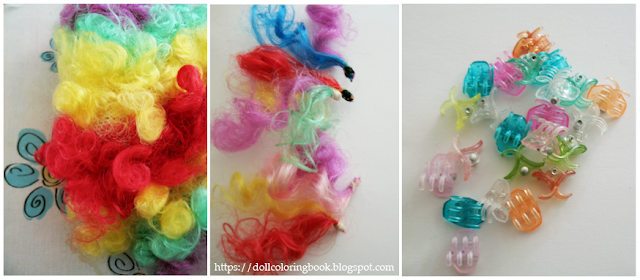I discovered a doll sized bookcase at resale. It was a bit too wide and heavy for a fashion doll bookcase and too small for an American Girl Doll's bookcase. So, I decided to convert it into a changing table for our Barbie's nursery.
 |
| A bookcase for a doll may be transformed into a very nice diaper changing table. |
- corrugated cardboard
- toothpicks
- acrylic paints
- clear acrylic varnish
- Mod Podge
- tacky white glue
- felt square
- printed fabric
- sandpaper (light weight)
- typing paper
- hot glue gun and hot glue
- masking tape
- Clean your resale item with soap and water and set it in the sunshine to dry thoroughly.
- Lightly sand the surfaces so that the paint will adhere to the item.
- I choose to paint my changing table with four colors: black, yellow, blue and green. These colors match flowers in the fabric print I selected for decoupage portion of the project. I first painted the top shelf yellow, then the middle shelf a turquoise blue, and the bottom shelf a hunter's green.
- Then using a tiny brush, I painted the changing table's decorative trim black. You may find that you need to repeat these steps several times to get good coverage.
- I used a ruler and typing paper to make patterns of the changing table sides and back pieces. Then I traced around these patterns on top of my fabric with a white piece of chalk.
- Cut the pieces out of the fabric and hold them up to the parts of the furniture you wish to decoupage to see if these are the correct size and shape.
- Brush on the Mod Podge and firmly press the fabric cuttings onto the sides and back of the changing table. Layer more Mod Podge on top of the fabric and then let the changing table dry overnight.
- Now measure the length of the shelves and cut two pieces of corrugated cardboard to fit the length that measure approximately 1/2 inch wide.
- Cut toothpicks down to half inch pieces. Make sure these are all the same length before assembling the railing for the top of the changing table.
- Using a tacky glue, squeeze a dot of glue on the end of each cut toothpick and nestle these inside every other hole of the corrugated cardboard interior. Let the glue harden before fitting the second piece of cut cardboard on top of the railing. This is tedious work but simple once you get used to it.
- Now let this small railing harden prior to painting it a color of your own choosing. I painted my railing bright yellow to match the top shelf.
- Glue the dry railing into place using a hot glue gun.
- Measure the inside of the top shelf to make a cardboard cut out for the changing pad.
- Cover the top of this cardboard with a piece of felt of the same size. Glue the felt into place with a small amount of tacky glue.
- Now lay this cardboard shelf on top of the decorative fabric and cut around the cardboard, leaving enough fabric to wrap it around the corners and a bit of the bottom. Secure the wrap with masking tape. (see photo below)
- Hot glue the upholstered changing pad onto the top of the changing table.
- Now you can fill the shelves with all kinds of items your Barbie's baby may need: diapers, wipes, toys, a bathtub etc...
 |
| Different views of my finished doll changing table. See the matching cradle for our Barbie's nursery. |

















































